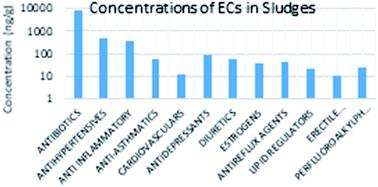当前位置:
X-MOL 学术
›
Anal. Methods
›
论文详情
Our official English website, www.x-mol.net, welcomes your feedback! (Note: you will need to create a separate account there.)
A multi-residue analytical method for extraction and analysis of pharmaceuticals and other selected emerging contaminants in sewage sludge
Analytical Methods ( IF 3.1 ) Pub Date : 2021-1-15 , DOI: 10.1039/d0ay02027c Francesco Riva 1, 2, 3, 4 , Ettore Zuccato 1, 2, 3, 4 , Carlo Pacciani 1, 2, 3, 4 , Andrea Colombo 1, 2, 3, 4 , Sara Castiglioni 1, 2, 3, 4
Analytical Methods ( IF 3.1 ) Pub Date : 2021-1-15 , DOI: 10.1039/d0ay02027c Francesco Riva 1, 2, 3, 4 , Ettore Zuccato 1, 2, 3, 4 , Carlo Pacciani 1, 2, 3, 4 , Andrea Colombo 1, 2, 3, 4 , Sara Castiglioni 1, 2, 3, 4
Affiliation

|
Sewage sludge is a by-product of wastewater treatment processes, and may be employed in agriculture as a fertilizer or in forestry for land reclamation. It is an important source of nutrients but its reuse can arouse concern on account of the wide range of contaminants that are retained and may persist during treatments. Information on the emerging contaminants (ECs) in sewage sludge in Italy is limited. The present study developed and applied a reliable analytical method for the analysis of 44 ECs in sewage sludge. ECs were extracted by accelerated solvent extraction followed by a clean-up step on solid-phase cartridges. High performance liquid chromatography coupled to mass spectrometry was used for analysis. The ECs, selected on the basis of their use and documented presence in the environment, were 42 pharmaceuticals belonging to 12 therapeutic categories and 2 perfluorinated substances. The method performance was good, with recoveries higher than 70%, good repeatability (<20%) and sensitivity in the low ng g−1 range, allowing measurement of the analytes selected. The method was applied for analysis of sludge from 12 wastewater treatment plants in Italy. The most abundant compounds were antibiotics, anti-inflammatories and antihypertensives and ranged up to 5 μg g−1 (ciprofloxacin). Seasonal differences were found for some antibiotics and anti-inflammatory drugs as well as some differences – in terms of concentration – with other European countries. This is the first Italian study to investigate the presence of a large number of ECs in sewage sludge and the results may be useful to drive future regulatory actions.
中文翻译:

一种用于分析和分析污泥中药物和其他选定新兴污染物的多残留分析方法
污水污泥是废水处理过程的副产品,可在农业中用作肥料或在林业中用于土地开垦。它是养分的重要来源,但由于在处理过程中会保留并可能持续存在多种污染物,因此其再利用可能引起关注。关于意大利污水污泥中新兴污染物(EC)的信息有限。本研究开发并应用了一种可靠的分析方法,用于分析污水污泥中的44种EC。通过加速溶剂萃取,然后在固相小柱上进行清洁步骤,萃取EC。高效液相色谱-质谱联用用于分析。EC的选择是根据其使用和环境中存在的文件证明的,有42种药物属于12个治疗类别和2种全氟化物质。该方法性能良好,回收率高于70%,重复性好(<20%),并且在低ng g的条件下灵敏度高-1范围,可测量所选的分析物。该方法用于意大利12个废水处理厂的污泥分析。最丰富的化合物是抗生素,抗炎药和抗高血压药,范围高达5μgg -1(环丙沙星)。发现某些抗生素和抗炎药的季节性差异,以及与其他欧洲国家的浓度差异。这是意大利的第一项研究,以研究污水污泥中大量EC的存在,其结果可能有助于推动未来的监管行动。
更新日期:2021-01-15
中文翻译:

一种用于分析和分析污泥中药物和其他选定新兴污染物的多残留分析方法
污水污泥是废水处理过程的副产品,可在农业中用作肥料或在林业中用于土地开垦。它是养分的重要来源,但由于在处理过程中会保留并可能持续存在多种污染物,因此其再利用可能引起关注。关于意大利污水污泥中新兴污染物(EC)的信息有限。本研究开发并应用了一种可靠的分析方法,用于分析污水污泥中的44种EC。通过加速溶剂萃取,然后在固相小柱上进行清洁步骤,萃取EC。高效液相色谱-质谱联用用于分析。EC的选择是根据其使用和环境中存在的文件证明的,有42种药物属于12个治疗类别和2种全氟化物质。该方法性能良好,回收率高于70%,重复性好(<20%),并且在低ng g的条件下灵敏度高-1范围,可测量所选的分析物。该方法用于意大利12个废水处理厂的污泥分析。最丰富的化合物是抗生素,抗炎药和抗高血压药,范围高达5μgg -1(环丙沙星)。发现某些抗生素和抗炎药的季节性差异,以及与其他欧洲国家的浓度差异。这是意大利的第一项研究,以研究污水污泥中大量EC的存在,其结果可能有助于推动未来的监管行动。



























 京公网安备 11010802027423号
京公网安备 11010802027423号